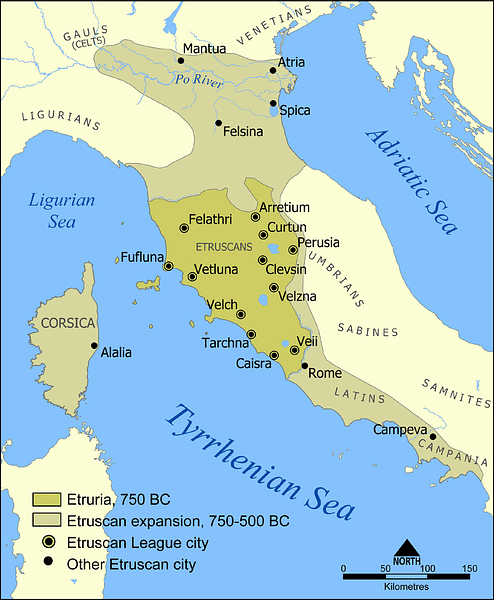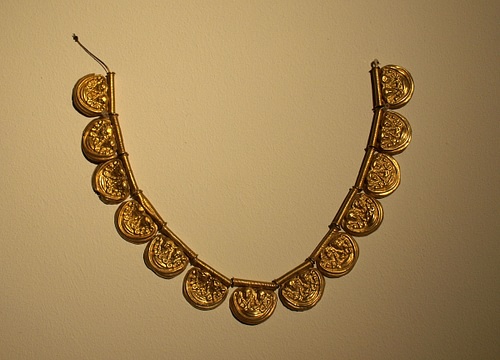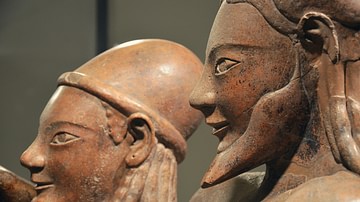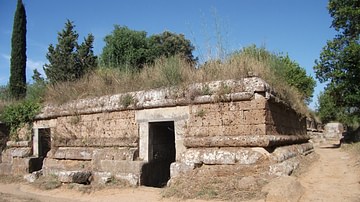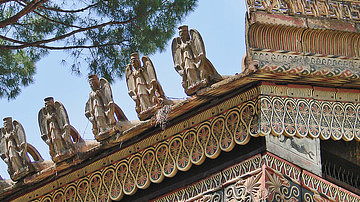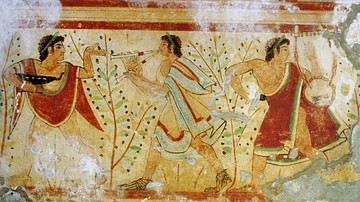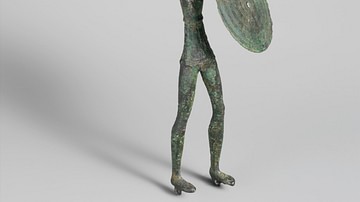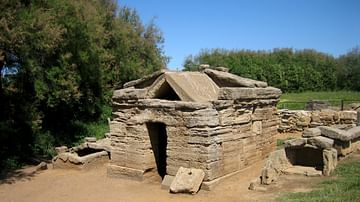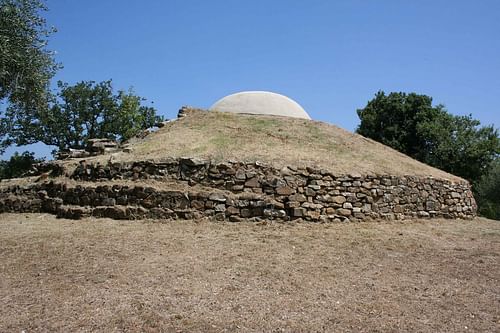
Vetulonia (Etruscan: Vetluna), located in the hills near the western coast of central Italy, was an important Etruscan town from the 9th to 3rd century BCE. The site has many impressive tumulus tombs which were rich in artefacts illustrating the eclectic nature of Vetulonia's metal industry and arts in general, as well as attesting to trade relations with Egypt, Phoenicia, the Near East, and Greece.
Villanovan Settlement
That Vetulonia was a Villanovan settlement is evidenced by the discovery of several circle tombs. These date to the Proto-Villanovan period (1100-900 BCE) and were constructed for elite burials using trenches surrounded by stones. They measure from 15 to 30 metres in diameter and contained multiple burials. Alternatively, simpler pit tombs contain the typical biconical urns of the Villanovan period – two ceramic vessels with the smaller one forming a lid – which contained cremated remains.
Etruscan Vetulonia
By the 8th century BCE, the Villanovan had matured into the Etruscan culture proper, and Vetulonia had two urban centres along with a large cemetery. Its prosperity was based on its location on Lake Prile and so easy access to both maritime and inland trade. Vetulonia, putting to good use the metal resources for which Etruria became famous (copper, iron, lead, and silver), was also a manufacturing centre in its own right; bronze figurines survive from this period. The population grew as a consequence, and the two urban centres joined.
Vetulonia became an important member of the Etruscan League, a loose confederacy of 12 (or perhaps 15) Etruscan towns. They included Cerveteri (Cisra), Chiusi (Clevsin), Populonia (Puplona), Tarquinia (Tarchuna), and Vulci (Velch). Very little is known of this league except that its members had common religious ties and that leaders met annually at the Fanum Voltumnae sanctuary near Orvieto (exact location as yet unknown).
Tumuli tombs continued to be built during the 7th century BCE but on a larger scale – some have a raised stone base 70 metres in diameter and contain multiple chambers. They are lined with stone slabs and surrounded by a number of smaller trench tombs. One such tomb, the Pietrera tumulus, has a single chamber with a corbelled roof supported by a single column. It contained eight almost life-size male and female figures, all standing, carved from limestone.
Finds within the Tomb of the Warrior included a large funerary stele of a warrior carrying a round shield, wearing a Corinthian plumed helmet, and wielding a double-headed axe, a symbol of authority. The 107 cm high sandstone stele is inscribed with the name of the deceased – Avele Feluske. From the Tombe del Duce were the remains of a chariot, a shield, helmet, and horse bits. From the same tomb, a bronze boat and glass paste beads suggest trade relations with Sardinia and Phoenicia, respectively. A silver cup attests to the cultural mix of Archaic Vetulonia with its Greek design but Phoenician decoration. Meanwhile, in the 7th-century BCE tomb Circle of Bes (Circolo di Bes) a faience amulet of that goddess, a figure of Ptah, and various scarabs and carved amber figures all illustrate connections with Egypt.
Many other tombs at Vetulonia were exceptionally rich with artefacts such as gold, silver, and amber jewellery, along with sheet and cast bronze works. A fine gold necklace with twenty pendants, each with two human heads, is evidence of Vetulonia's continued craftsmanship in metal. Vetulonian dentists also put gold to good use to create holding wires and false teeth (both single and complete dentures). Bronzework, specifically, takes the form of bowls, censers, ornate tripods and candelabra. One tomb, the Tombe del Littore (Tomb of the Lictors), contained an axe bound with iron rods, the fasces symbol later adopted by magistrates of the Roman Republic, confirming the claim made by the 1st-century CE Roman writer Silius Italicus that the original fasces, ironically a royal symbol, did come from Etruscan Vetulonia. Another common find is bucchero wares, the Etruscan pottery with a distinctive black shiny finish. Finally, the tomb known as the Circolo dei Lebeti, contained bronze cauldrons decorated with heads of sirens and griffins which illustrate, once again, the relations early Etruria enjoyed with the Greek and Near East cultures.
Local Rivalries
During the 6th to 5th century BCE, Vetulonia built city walls to enclose its now 120 ha, perhaps an indication of an increasing threat from their neighbours as competition for resources increased. Roselle (Rusellae) was a particularly prominent neighbour. Although a dip in fortunes seems evident during the mid-6th to mid-5th century BCE and Vetulonia was attacked along with several other Etruscan coastal ports by a fleet from Syracuse in 454 BCE, thereafter, the city continued to thrive despite these rivalries. This is attested by the continued construction of large tumuli tombs and the establishment of satellite communities, notably at Lago dell' Acesa with its important mines. The 5th century BCE was marred by more conflict if the discovery of 125 bashed and incised bronze helmets buried in a ditch by the city walls are taken as tangible evidence of rivalry with other Etruscan towns.
New urban buildings were built in the 4th and 3rd century BCE which include shops and housing, albeit without a marked degree of town planning. One such house, the House of the Terracotta, had an impressive terracotta frieze with figures 40 cm high. The city walls were also repaired in this period, and coins were minted and inscribed with vatl. The end of Etruscan Vetulonia came with the expansion of Rome and its conquest of Etruria throughout the 2nd and 1st century BCE.
